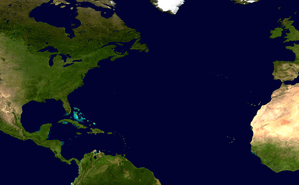Hurricane Leslie (2018)
| Category 1 hurricane (SSHWS/NWS) | |
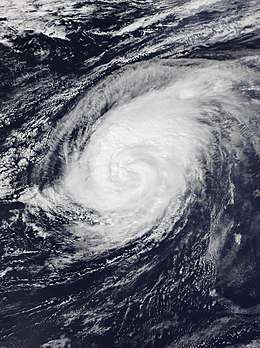 Hurricane Leslie near peak intensity southwest of the Azores on October 11 | |
| Formed | September 23, 2018 |
|---|---|
| Dissipated | October 14, 2018 |
| (Extratropical after October 13) | |
| Duration | 2 weeks and 4 days |
| Highest winds |
1-minute sustained: 90 mph (150 km/h) |
| Lowest pressure | 969 mbar (hPa); 28.61 inHg |
| Fatalities | None reported |
| Damage | Unknown |
| Areas affected | East Coast of the United States, Bermuda, Azores, Madeira, Iberian Peninsula |
| Part of the 2018 Atlantic hurricane season and the 2018–19 European windstorm season | |
Hurricane Leslie (known as Storm Leslie in Spain and Portugal while extratropical) was the strongest cyclone to hit the Iberian Peninsula since 1842 and one of the longest-lasting Atlantic hurricanes on record.
A large, long-lived, and erratic tropical cyclone, Leslie was the twelfth named storm and sixth hurricane of the 2018 Atlantic hurricane season. The storm had non-tropical origin, developing from a large low pressure system that developed over the northern Atlantic Ocean on September 22. The low quickly acquired subtropical characteristics and was classified as Subtropical Storm Leslie on the following day. The cyclone meandered over the northern Atlantic and gradually weakened before being absorbed by a frontal system on September 25, which later intensified into a powerful hurricane-force low over the north Atlantic. While Post-Tropical Cyclone Leslie began to weaken on September 27, it simultaneously began to reacquire subtropical characteristics, and by late on September 28, Leslie had completed the transition to a subtropical storm once again. Leslie gradually intensified, becoming a hurricane early on October 3, and initially peaked with winds of 80 mph (130 km/h) later that day. Leslie gradually weakened, falling to tropical storm intensity late on October 4. The cyclone continued to slowly weaken before beginning to re-strengthen on October 8. On October 10, Leslie reached hurricane status for a second time. Leslie continued to slowly strengthen, reaching peak intensity with sustained winds of 90 mph (150 km/h) and a minimum central pressure of 969 mbar (28.62 inHg), on October 12. Leslie then began to gradually weaken over the next day, while accelerating towards the northeast, before transitioning into an extratropical cyclone just off the coast of Portugal on October 13.
Hurricane Leslie prompted the issuance of tropical storm watches and warnings for Madeira Island, the first in recorded history.[1]
Meteorological history
Origins and initial extratropical transition
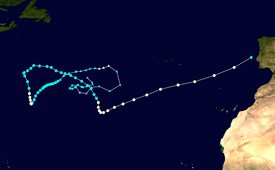
On September 19, in the midst of an active month of tropical cyclone formation in the North Atlantic basin, the National Hurricane Center (NHC) began monitoring the potential for a non-tropical low pressure system to form several hundred miles southwest of the Azores, with the possibility of the low gradually acquiring tropical or subtropical characteristics.[2] Three days later, on September 22, a non-tropical low formed along a frontal boundary about 850 miles south-southwest of the Azores.[3] The low quickly acquired subtropical characteristics as it meandered over the northeastern Atlantic, and at 15:00 UTC on September 23, the NHC initiated advisories on Subtropical Storm Leslie.[4]
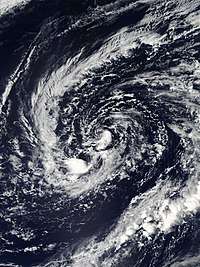
Initially, the future evolution of Leslie was rather uncertain, due to the possibility of a larger low pressure system becoming dominant and absorbing Leslie, although some global forecast models maintained Leslie as the dominant system.[5] Over the next couple of days, Leslie drifted eastward without changing in intensity before weakening into a subtropical depression at 03:00 UTC on September 25.[6][7]
Six hours later, Leslie became an extratropical cyclone. Microwave data showed that the system had a surface circulation elongated around an intruding baroclinic zone.[8] At 18:00 UTC on September 25, the NHC forecasted that Leslie would regain subtropical characteristics in a couple days.[9] On September 27 at 00:00 UTC, Leslie acquired hurricane-force winds due to baroclinic processes.[10] As Leslie began to regain subtropical characteristics, it weakened to tropical storm force strength.[11] At 21:00 UTC on September 28, the NHC resumed issuing advisories on Leslie as a subtropical storm, as its organization had increased and baroclinic features had disappeared.[12]
Tropical transition, initial peak and subsequent weakening
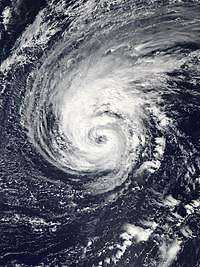
Soon after being reclassified as a subtropical storm, Leslie began to turn due to interactions with the subtropical ridge to the west and a large deep-layer low that was forming to the east. Over the course of a day, Leslie turned from a westerly direction to the southwest.[12][13] At the same time, Leslie was acquiring more tropical characteristics. On September 29 at 21:00 UTC, Leslie became fully tropical after developing an anticyclonic outflow to its northeast and southeast as well as in its main convective band. Additionally, Leslie had transitioned to a warm core structure.[14]
For the next day and a half, Leslie meandered over the north Atlantic without any change in intensity. At 09:00 UTC on October 1, Leslie began to strengthen with the NHC noting an increase in convective banding in the north and northwest.[15] Leslie continued to slowly strengthen over the next couple of days, before becoming a hurricane on October 3 at 09:00 UTC.[16] At that time, deep convection surrounding Leslie had immensely improved and a well defined low-level eye had developed. Additionally, steering currents that had been taking Leslie southwestward over the last several days completely collapsed, resulting in the hurricane becoming stationary.[17] Six hours later, at 15:00 UTC, Leslie reached its initial peak intensity with maximum sustained winds of 80 mph (130 km/h) and a minimum central pressure of 975 mbar (28.80 inHg).[18] At 21:00 UTC, Leslie began to move northward under the influence of a shortwave trough to the northwest and a mid-level ridge to the southeast.[19]
Leslie maintained peak intensity for twelve hours before beginning to weaken.[20] On October 4 at 21:00 UTC, Leslie weakened into a tropical storm.[21] Leslie's structure continued to degrade with the NHC noting that the system lacked an inner wind core.[22] Over the next few days, Leslie turned from the north to the southeast, as it encountered the southern edge of the mid-latitude westerlies.[23] Leslie continued to gradually weaken, weakening to a tropical storm with winds of 50 mph (85 km/h) on October 8, at 03:00 UTC.[24]
Peak intensity, second extratropical transition and demise
On October 8 at 21:00 UTC, Leslie began to strengthen once more.[25] Convection had deepened and an inner core was trying to form in the tropical storm. Additionally, the cloud pattern of Leslie had become more symmetric.[26] Over the next day, Leslie continued to strengthen, reaching hurricane status for a second time at 03:00 UTC on October 10.[27] At 09:00 UTC, Leslie turned southward, under the influence of a broad mid- to upper-level trough.[28] Over the next eighteen hours, Leslie turned from the south to the east-northeast, due to a mid-latitude trough.[29] Leslie continued to slowly strengthen, reaching its peak intensity with sustained winds of 90 mph (150 km/h) and a minimum central pressure of 969 mbar (28.62 inHg), on October 12 at 03:00 UTC.[30] Leslie maintained its peak intensity for six hours before beginning to weaken once more.[31]
Leslie continued to gradually weaken over the next day, as it accelerated to the northeast.[32] At 18:00 UTC on October 13, Leslie fell below hurricane strength as it transitioned into an extratropical cyclone.[33] Three hours later, the NHC issued its last advisory on Leslie as it approached the western coast of Portugal.[34] Soon afterward, Leslie's extratropical remnant made landfall in Figueira da Foz at 21:10 UTC, causing damage throughout the country's central coast.[35]
Preparations and impact
Madeira
Late on October 11, the Government of Portugal issued a tropical storm watch for Madeira Island,[36] which was changed to a tropical storm warning six hours later.[37] It was the first known tropical storm warning issued for that island in recorded history.[1] Madeira officials closed beaches and parks.[38] The threat of the storm caused eight airlines to cancel flights into Madeira. More than 180 sports matches on the island were canceled, more than half of which affecting the Madeira Football Association.[39] The warnings were discounted on October 13 as Leslie moved away from the islands.[40]
Portugal
In advance of Leslie, IPMA issued red warnings for high winds or dangerous coastal conditions for 13 out of its 18 districts, including the capital Lisbon. At 21:10 UTC on October 13, Leslie made landfall in Figueira da Foz as a storm-force extratropical cyclone winds of 70 mph (110 km/h). The country recorded winds up to 110 mph (175 km/h), and it was affected by heavy rains and strong waves, leaving 300,000 homes without power. At least 1,000 trees were uprooted in the coastal areas. As of October 14, 27 people were injured, but no deaths was reported. Leslie was regarded as the first storm of tropical origin to hit the Iberian Peninsula since Vince in 2005, as well as the strongest storm to hit the peninsula since 1842.[41] Several events were canceled or postponed, including the Revenge of the 90s party scheduled for the night of October 13 in Lisbon being postponed to the 20th. A Mafalda Veiga concert in Campo Pequeno, the play "Baixa Terapia" at the Tivoli BBVA, and the evening session of the French Film Festival were also canceled.[42]
See also
- Tropical cyclone effects in Europe
- Hurricane Ginger (1971) – the second longest-lasting Atlantic hurricane on record; took an erratic track across the western Atlantic
- Hurricane Nadine (2012) – long-lived and erratic hurricane of similar intensity
- Hurricane Ophelia (2017) – the easternmost Atlantic major hurricane on record; had similarly severe impacts in Ireland and the United Kingdom as an extratropical cyclone
References
- 1 2 Eric S. Blake (October 12, 2018). Hurricane Leslie Discussion Number 63 (Report). Miami, Florida: National Hurricane Center. Retrieved October 12, 2018.
- ↑ David Zelinsky (September 21, 2018). NHC Graphical Tropical Weather Outlook Archive (Report). Miami, Florida: National Hurricane Center. Retrieved September 22, 2018.
- ↑ Michael J. Brennan (September 22, 2018). NHC Graphical Tropical Weather Outlook Archive (Report). Miami, Florida: National Hurricane Center. Retrieved September 23, 2018.
- ↑ Lixion Avila (September 23, 2018). Subtropical Storm Leslie Discussion Number 1 (Report). Miami, Florida: National Hurricane Center. Retrieved September 23, 2018.
- ↑ Lixion Avila (September 23, 2018). Subtropical Storm Leslie Discussion Number 3 (Report). Miami, Florida: National Hurricane Center. Retrieved October 8, 2018.
- ↑ Roberts, Dave. Subtropical Storm Leslie Advisory Number 6. National Hurricane Center (Report). National Oceanic and Atmospheric Administration. Retrieved 11 October 2018.
- ↑ Zelinsky, David. Subtropical Depression Leslie Advisory Number 7. National Hurricane Center (Report). National Oceanic and Atmospheric Administration. Retrieved 11 October 2018.
- ↑ Roberts, Dave. Post-Tropical Cyclone Leslie Discussion Number 9. National Hurricane Center (Report). National Oceanic and Atmospheric Administration. Retrieved 11 October 2018.
- ↑ Pasch, Richard. NHC Graphical Outlook Archive. National Hurricane Center (Report). National Oceanic and Atmospheric Administration. Retrieved 11 October 2018.
- ↑ Berg, Robbie. NHC Graphical Outlook Archive. National Hurricane Center (Report). National Oceanic and Atmospheric Administration. Retrieved 11 October 2018.
- ↑ Zelinsky, David. "NHC Graphical Outlook Archive". National Hurricane Center. National Oceanic and Atmospheric Administration. Retrieved 11 October 2018.
- 1 2 Beven, Jack. Subtropical Storm Leslie Discussion Number 10. National Hurricane Center (Report). National Oceanic and Atmospheric Administration. Retrieved 11 October 2018.
- ↑ Zelinsky, David. Subtropical Storm Leslie Advisory Number 13. National Hurricane Center (Report). National Oceanic and Atmospheric Administration. Retrieved 12 October 2018.
- ↑ Zelinsky, David. Tropical Storm Leslie Discussion Number 14. National Hurricane Center (Report). National Oceanic and Atmospheric Administration. Retrieved 12 October 2018.
- ↑ Brown, Daniel. Tropical Storm Leslie Discussion Number 20. National Hurricane Center (Report). National Oceanic and Atmospheric Administration. Retrieved 13 October 2018.
- ↑ Brown, Daniel. Hurricane Leslie Discussion Number 28. National Hurricane Center (Report). National Oceanic and Atmospheric Administration. Retrieved 13 October 2018.
- ↑ Brown, Daniel. Hurricane Leslie Discussion Number 28. National Hurricane Center (Report). National Oceanic and Atmospheric Administration. Retrieved 13 October 2018.
- ↑ Cangialosi, John. Hurricane Leslie Advisory Number 29. National Hurricane Center (Report). National Oceanic and Atmospheric Administration. Retrieved 13 October 2018.
- ↑ Cangialosi, John; Onderlinde, Matthew. Hurricane Leslie Discussion Number 30. National Hurricane Center (Report). National Oceanic and Atmospheric Administration. Retrieved 13 October 2018.
- ↑ Berg, Robbie. Hurricane Leslie Advisory Number 32. National Hurricane Center (Report). National Oceanic and Atmospheric Administration. Retrieved 13 October 2018.
- ↑ Beven, Jack. Tropical Storm Leslie Advisory Number 34. National Hurricane Center (Report). Retrieved 13 October 2018.
- ↑ Avila, Lixion. Tropical Storm Leslie Discussion Number 35. National Hurricane Center (Report). National Oceanic and Atmospheric Administration. Retrieved 13 October 2018.
- ↑ Beven, Jack. Tropical Storm Leslie Discussion Number 38. National Hurricane Center (Report). National Oceanic and Atmospheric Administration. Retrieved 13 October 2018.
- ↑ Avila, Lixion. Tropical Storm Leslie Advisory Number 47. National Hurricane Center (Report). National Oceanic and Atmospheric Administration. Retrieved 13 October 2018.
- ↑ Blake, Eric. Tropical Storm Leslie Advisory Number 50. National Hurricane Center (Report). National Oceanic and Atmospheric Administration. Retrieved 13 October 2018.
- ↑ Blake, Eric. Tropical Storm Leslie Discussion Number 60. National Hurricane Center (Report). National Oceanic and Atmospheric Administration. Retrieved 13 October 2018.
- ↑ Blake, Eric. Hurricane Leslie Advisory Number 55. National Hurricane Center (Report). National Oceanic and Atmospheric Administration. Retrieved 13 October 2018.
- ↑ Cangialosi, John. Hurricane Leslie Discussion Number 56. National Hurricane Center (Report). National Oceanic and Atmospheric Administration. Retrieved 13 October 2018.
- ↑ Zelinsky, David. Hurricane Leslie Discussion Number 58. National Hurricane Center (Report). National Oceanic and Atmospheric Administration. Retrieved 13 October 2018.
- ↑ Blake, Eric. Hurricane Leslie Advisory Number 63. National Hurricane Center (Report). National Oceanic and Atmospheric Administration. Retrieved 13 October 2018.
- ↑ Brennan, Michael. Hurricane Leslie Advisory Number 65. National Hurricane Center (Report). National Oceanic and Atmospheric Administration. Retrieved 13 October 2018.
- ↑ Avila, Lixion. Hurricane Leslie Advisory Number 69. National Hurricane Center (Report). National Oceanic and Atmospheric Administration. Retrieved 13 October 2018.
- ↑ Avila, Lixion. Post-Tropical Cyclone Leslie Tropical Cyclone Update. National Hurricane Center (Report). National Oceanic and Atmospheric Administration. Retrieved 13 October 2018.
- ↑ Stewart, Stacy. Post-Tropical Cyclone Leslie Advisory Number 70. National Hurricane Center (Report). Retrieved 13 October 2018.
- ↑ "A tempestade Leslie entrou pela Figueira da Foz e fustigou o Centro" (in Portuguese). Diário de Notícias. October 14, 2018. Retrieved October 14, 2018.
- ↑ David Zelinsky (October 11, 2018). Hurricane Leslie Advisory Number 62 (Report). Miami, Florida: National Hurricane Center. Retrieved October 12, 2018.
- ↑ Eric S. Blake (October 12, 2018). Hurricane Leslie Advisory Number 63 (Report). Miami, Florida: National Hurricane Center. Retrieved October 12, 2018.
- ↑ "Arquipélago da Madeira em "alerta máximo" devido ao furacão Leslie" (in Portuguese). Diário de Notícias. October 12, 2018. Retrieved October 12, 2018.
- ↑ "Furacão Leslie: mais de 180 jogos cancelados na Madeira e duas exceções nas modalidades" (in Portuguese). O Jogo. October 12, 2018. Retrieved October 12, 2018.
- ↑ Lixion A. Avila (October 13, 2018). Hurricane Leslie Intermediate Advisory Number 68A (Report). Miami, Florida: National Hurricane Center. Retrieved October 13, 2018.
- ↑ "Storm Leslie: Portugal hit by 110mph winds as thousands of homes lose power". Sky News. October 14, 2018. Retrieved October 14, 2018.
- ↑ Lusa, Carolina Branco, Rita Cipriano, Agência. "Furacão Leslie. A maior tempestade desde 1842". Observador (in Portuguese). Retrieved 2018-10-14.
External links
| Wikimedia Commons has media related to Hurricane Leslie (2018). |
- The National Hurricane Center's advisory archive on Hurricane Leslie
![]()
